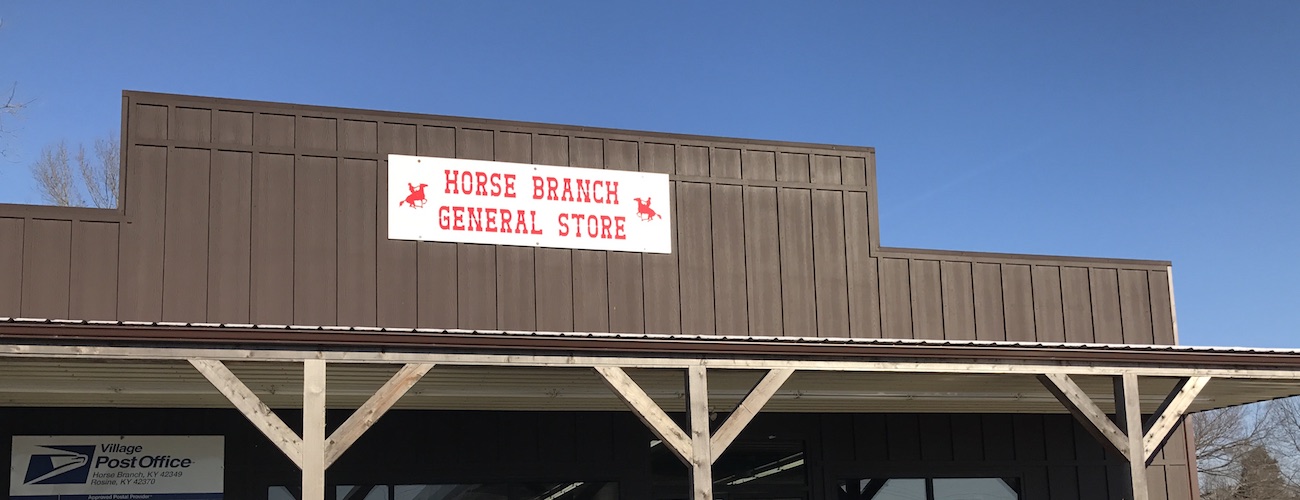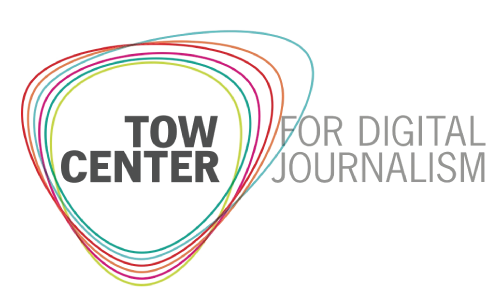Editor’s note: This article is the second of two in a series on innovation in rural journalism. The first, “Sourcing innovation from a ‘rural journalism lab,’ ” can be found here.
LEE BRATCHER ISN’T THRILLED about waking up at 5:15am to make his way to what in rural Ohio County, Kentucky, qualifies as the public sphere. He and his brother, Dustin, are going to see farmers and workers who rise early to meet for breakfast before work.
“I don’t know if this is going to work,” Dustin recalls, summing up his state of mind that first morning of their “liars table” tour.
Liars tables have long been a hub of local information in rural communities, whether in local diners or general stores, most of which double as gas stations today. In communities like McHenry, Kentucky—a town with a total square area of .7 miles—there used to be more places to gather, one man tells us. But since post offices have reduced their hours and diners and smaller schools have closed, residents seeking information and camaraderie mostly convene at local stores.
From farmers and miners, to local politicians wanting to take the pulse of the community, “Wherever you go, there’s certain places…that if you really want to get to know anything, that’s where you go to find out,” one regular says.
RELATED: Before Facebook, society columns provided news—and community
Dustin and Lee, who founded the digital hyperlocal news site The Ohio County Monitor in 2012, are traveling around the 600-square-mile county as part of a liars table listening tour. It’s been a little over six months since The Monitor shifted to a $5-per-month subscription model. The brothers are looking for the best ways to build a meaningful relationship with the community of 24,000 and drive financial investment in their journalism.
Over the course of three months, the Bratchers partnered with us as part of our research for the Tow Center for Digital Journalism to run a series of pilot experiments around Facebook outreach, livestreaming, podcasting, and local partnerships. (For an in-depth review of outcomes, see our first CJR piece in this series.) Ultimately, the initiatives that inspired the most enthusiasm for their new subscription model involved reimagining long-standing traditions like liars tables and society columns as community engagement initiatives. We followed The Monitor’s efforts along the way, interviewing participants and conducting surveys at the start and end to assess their impact.
The Liars Table Tour
“We’ve got a man down there, and he likes to tell good tales, and he said it’s only a lie if you believe it. And anything anybody says, we don’t believe it, so it’s not a lie.” —liars table participant
“We settle the world’s problems,” says one man who sits inside a store in McHenry, Kentucky. For some stretch of each morning, he joins a few neighbors for a cup of coffee or breakfast before work. They talk about obituaries and stories of those who have passed, local issues like if a store is opening or closing, the risk of school consolidation or losing the local post office, and whether someone in the area is sick and needs help.
Lee is concerned that adding a pair of reporters to the mix will, at best, be awkward. “They’re used to each other, and they all know each other,” he says. “They can joke around with each other. They probably don’t have to hold back from each other, and then you have two or three guys just out of the blue showing up and sitting down, and you’re just sitting there. . .Really, I expected them all to just, you know, kind of shut us out.”
Their worries are not entirely unfounded.
“They’re taking up somebody’s seat,” says one regular who had never heard of The Monitor or the Bratchers. While the man jokes that they must come from the “upper class,” he eventually concedes, “if they get there early enough to get them a spot then, yeah, they’re welcome.”
Many liars table participants admit that they’re not online (though several mention their wives reading The Monitor). In rural areas, spotty mobile connections and a lack of broadband internet mean that the internet is not necessarily integral to daily life. This makes The Monitor’s offline engagement in communication hotspots (e.g., the general stores) all the more crucial to building ties between residents and the local media.
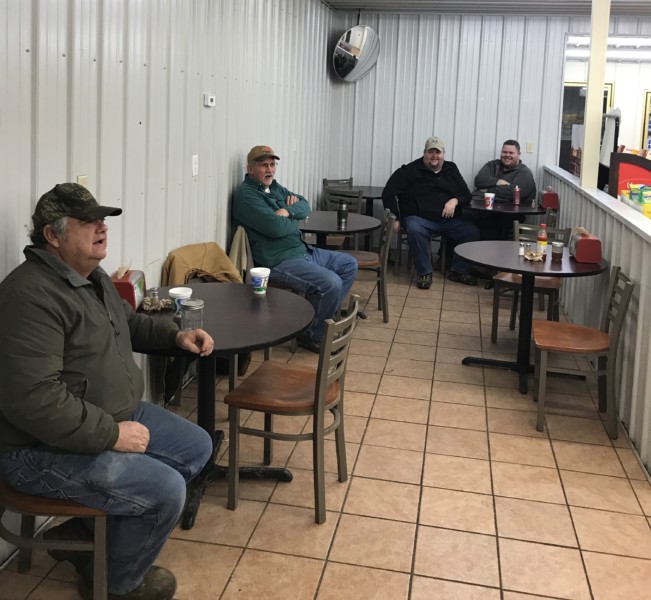
Dustin and Lee Bratcher chat with two of eight or so local residents who passed through during their time at the Raceway Market in McHenry, Kentucky.
In a different part of the county at the Horse Branch General Store, one man is skeptical: “We’ll see what the results are three to six months from now about what their visit was and issues we talked about.” He is vocal in saying that he isn’t interested in talking with The Monitor if they are just there to visit. He wants to see them “put an effort to help with what we need in this community.”
Conversation has mostly centered around challenges with the internet and public demands for a dollar store. The man worries that the only way to keep their community’s school open is to get a grocery store—and he sees a dollar store as the most likely bet.
It turns out, not everyone is so doubtful. In a follow-up interview, two men at the first tour stop mention that they think the visit and discussion about local concerns has already had a positive outcome: “I don’t know if they reported it or not, but we were having issues with the coal trucks. They go through so fast, and we were afraid they was going to hit the school bus. Well, since that time, somebody must have got ahold of somebody because they’ve slowed down.”
The Bratchers say that while they remember discussing the issue of the coal trucks, they didn’t report it to any officials or cover it on their website. Nevertheless, liars table participants clearly perceived that their conversation with the reporters led to solving a local problem. Be it a placebo effect or coincidence, even this limited and rare interaction with local media can elevate expectations.
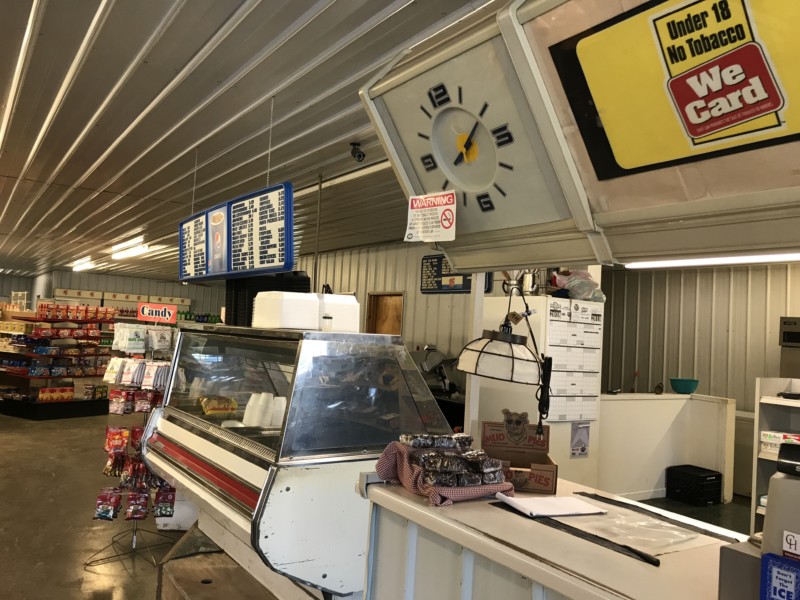
The counter at Bishop’s Grocery in Centertown, Kentucky. Of the stores in Ohio County that host liars table, it is one of the few left that is independently owned.
For Lee, community expectations are more of a motivator than a deterrent. He points out that, in a rural context, “one person really can make a difference.” One or two calls to a magistrate can lead to a change, like slowing down the speed of passing coal trucks.
Based on this initial “tour,” The Monitor plans to follow up on this thread of engagement through a regular series of columns on its site drawing from future tours. The ongoing columns will aim to connect readers in different parts of the county (and those who might not feel welcome in these exclusively white and male spaces) by letting them know about issues being discussed across a number of small communities throughout the area.
Future “From the Liars Table” columns may follow Chatham House Rule, where participants’ names are not used. This would encourage candor. As one participant said of the conversations in acknowledgment of the gendered nature of the space and information flow, if they were women they’d be called gossipers. But since they’re men, they’re just keeping “up on local happenings.” Added another man, “Some of it, nobody needs to know about.”
From ‘Society Columnist’ to ‘Community Contributor’
“I think that this might be a way of Ohio County to write its story.” —community contributor
Society columns have been a mainstay of rural journalism going back for decades. From births to illness, community tragedies and triumphs, small-town society columnists recounted the events, often writing in exchange for a free newspaper subscription.
These days, the void of place-based news left by fewer newspapers and far fewer society columns hasn’t been filled by Facebook in communities like those in Ohio County.
Responding to ideas that grew out of our workshop, The Monitor invited residents to weigh in on what (if anything) they wanted to see from a contemporary imagining of the society column. Some 110 residents responded to a survey, offering a range of views. A number of people suggested a fairly traditional approach that included “local happenings” and personal announcements—particularly about positive developments, or a notice of how people could help when bad things happened.
Some voiced an interest in historical content like “this day in history” features. Several participants suggested “less of who visited with whom,” and more about achievements of community members, efforts of local government to address problems, and coverage (not just announcements) of community events. While there were some grumblings that traditional columnists tended to have an insular focus that centered on their own family and friends, several were optimistic that an updated model could introduce a new range of perspectives.
Following the initial survey, The Monitor put out a call for residents interested in becoming community contributors. Dustin’s fears that recruitment would be challenging proved unfounded. Seven people volunteered for an informal training and workshop to share ideas. In the end, a cohort of five (the original target goal) followed through in writing and publishing pieces. Contributors were invited to write on anything they wanted, “as long as your focus is on this community or has a community tie of some sort—and it might be that the only tie to the community is that you are from the community.”
“I thought this would be a good chance for me to see if I can write creatively,” one community contributor explained. Reflecting on motivations for participating, several contributors talked about wanting to try their hand at writing for an audience. Creative curiosity often paired with a sense of wanting to contribute to the community in some way. This generally meant speaking from places of personal experience. Two contributors with professional backgrounds in health wrote columns on health issues, one on healthy drinking choices and one on the stigma against smokers who suffer from lung cancer. A woman in her thirties reflected on her own path to becoming civically active. A retired woman shared her experience of a bluegrass-themed epiphany and how she came to finally feel at home in the county after decades of residency.
One of the most popular articles was a 3000-word story about a retired band teacher. With nearly 900 views over the course of two days, it had more traffic than most crime stories—which usually dominate The Monitor’s views. Its author says that the subject of his story was a “local hero.” In the current climate of “political craziness” and negativity, he wanted to offer a story of a good man overcoming adversity: “I chose it because I felt like it would be a good taste in people’s mouth.”
Several other contributors expressed a similar sentiment in wanting to deliver positive narratives for the community. A contributor’s article about smoking cessation included a critique of the stigmatization of people with lung cancer. She says she received messages from people she didn’t even know saying, “Hey, great story. Thank you for standing up for the smoker. We know we don’t need to smoke, but thank you for treating us like human beings.”
ICYMI: Facebook under fire following data-breach reports
Lee admits he was relieved to see the stories get a positive reception: “When I put their stories out, I’m more protective over [them] than even my own stuff, because I want everybody to like their stuff. . .they’re kind of like, they’re a guest in my home, and I want everybody to treat them right.”
Before publishing the stories, he even cautioned contributors to keep their expectations around number of views and shares in check: “A lot of people are just kind of the lookie-loos that want to see the crime and the obituaries and stuff. The folks that are going to be reading theirs are the folks that are buying into what we’re trying to do and the people that are going to be the ones to kind of step up and take action,” he says.
But the numbers were actually strong for the community contributor stories. And, when they held a public discussion at the library with all the contributors, they had a full room. The session not only allowed members of the audience (including several who expressed an interest in becoming contributors) to interact with those who wrote stories, but also for the contributors to share experiences with each other.
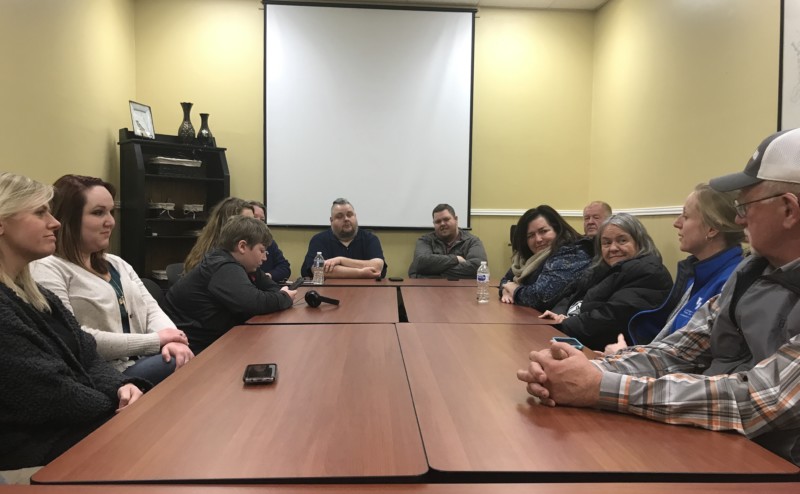
Dustin and Lee Bratcher talk with participants in their community contributor pilot program, along with other interested local residents, at an event at the Ohio County Public Library in Hartford, Kentucky.
“When you have that face-to-face, it’s more of that connection with people,” one of the community contributors says. “You actually start developing a relationship, and it’s better, you know.”
Another says she wasn’t sure what to expect at the library, “I didn’t know if we were going to have to read our pieces out loud.” (They didn’t.) She sees herself more as a poet than a writer and was a bit hesitant about how she would fit in as a contributor, and about “what you’re supposed to put in the newspaper.” Ultimately, though, she thinks the process of sharing and getting feedback from the other contributors helped her with her writing. “Everybody just kind of encouraged each other.”
These meetings, and the earlier brainstorming workshops The Monitor hosted, allowed contributors to build confidence as writers: “I think, collectively, we felt in the beginning that we weren’t going to be very good writers, and there was a couple of people that really felt like what they wrote about was not even what they were looking for. Come to find out, even though all five of our pieces were completely different, they were all good reads, and they, you know, people have different opinions and thoughts.”
Several contributors tell us they hope such meetings, or what one called a “brain trust,” would take place monthly as a source of support.
Some, though, see room for improvement. One contributor says she’d like to see more community members participate in the future. “I think sometimes if when you write for an audience you need to remember who you’re writing for and be willing to listen and take what they have to share and how your piece affected them,” she says, suggesting The Monitor may need to offer free pizza and beer to get non-contributors to come. It would be worth it to get more input, rather than “hearing us pat each other on the back,” she says.
The woman also believes the community contributor program could recruit more people by surveying readers about what they want to read about: “Are there areas of the county that they feel are less exposed and that they want to know a little bit more information about?. . .I think there’s a lot of people who, they love the content, they love to read it, they just don’t think they have the ability to actually write down something coherent and well enough to get published. But they could do a lot by just providing a lot of the basic information and just getting someone else to write it up for them.”
Community contributors, according to her suggestion, could potentially play the role that professional reporters do in engagement models such as Hearken—following up with members of the public who nominate ideas for stories. She is not alone in this thinking. Another contributor mentions the possibility of becoming a writing buddy for a would-be contributor who has access to a distant section of the county but needs writing support.
At least one community member, who responded to our project-end survey, seems to support this need: “Do you have resources for someone in the community who would like to contribute but may not be the best writer? Are there polls where people can submit ideas or opinions that can be incorporated into someone else’s work, or they can be helped into developing their own piece?”
Opening The Ohio County Monitor to community contributors definitely strengthens its relationship with the community, another contributor says. “They have an opportunity there to build a site that people frequent for more than just what’s going on in the community from a news standpoint, but also what’s going on from a social standpoint or what’s going on and how people can get involved a little bit more on some of the more current events—how that actually relates to people throughout the community.”
Another contributor agrees that The Monitor can add value to a shared sense of community. “I think it will be the one thing, or will become the one thing, that keeps people tied to the county.”
The Results
Healthy storytelling networks, according to communication infrastructure theory, have strong connections between residents, community organizations, and local media. They allow everyone to share a common story of what is happening in their community, and what issues may need to be addressed. While The Monitor’s experiments are too new to generate conclusive change in the storytelling network, they point to at least limited signs of promise in intervening and improving on the area’s larger storytelling network.
First, the liars table tours established a previously absent link between residents and local media. Many liars table regulars expressed an appreciation to the local reporters for showing up—despite a persistent and entrenched skepticism.
One participant, who suggested that media coverage was biased and depended on “who you knew,” says, “It hasn’t changed in 50 years, so I don’t see it changing for another 50 years.” Others suggested that what made the local news usually didn’t really affect them, or, if it did, they’d “hear it really quick the next morning at the store.” Forging meaningful ties between The Monitor and liars table participants will require an ongoing process of building trust and demonstrating relevance by opening the county-wide news agenda to issues of hyperlocal concern.
Likewise, the community contributor program allowed The Monitor to deepen ties not only with its contributors, but also with those contributors’ interpersonal networks. Most spoke of their efforts to share stories with and even recruit additional contributors from their extended circles.
And while community organizations were not explicitly involved in the project, community contributors often referenced them in their stories. For example, after one contributor’s column encouraged people to “stop complaining” and become more active in the community, another noticed an uptick of clicks and likes on a community organization’s Facebook page that the contributor’s column linked to. Given it was an off-season for that organization, she concluded that the column had driven readers to connect with the organization online.
Community engagement and belonging
Research finds that strong storytelling networks lead to higher levels of civic engagement and a greater sense of community belonging. Again, it’s too early to draw firm conclusions, but among participants in The Monitor’s initiatives we saw indications of this.
“When I heard these other pieces, it made me want to get a little bit more involved,” says one community contributor. After hearing about opportunities from other contributors, she is now thinking about volunteering at a women’s shelter. Several participants say the process made them aware of new opportunities and prompted them to consider different ways to become more active.
At the same time, there are limits that participants bumped up against. According to some liars table participants, particularly in the more distant corners of the county, there are historical reasons they don’t feel motivated to get involved: “This is in a rural area, and, you know, there’s been so many things promised around here about things that that haven’t come true for the community.”
Even liars table participants who expressed skepticism about the media and civic initiatives, however, communicated a deep attachment to home and place. Similarly, in discussion with community contributors at the library, members of the public mentioned the concept of belonging without prompting:
“There was a lot of conversation about a sense of place and sense of, like, belonging in that community. And this is something that I’ve noticed across this region in rural communities, is this feeling of, like, being really tied to tradition and a sense of place and wanting to, like, lift up your community despite this feeling of, like, lack of opportunity or things that come with being in a rural area.” —library event attendee
“I’ve only lived in Ohio County for seven years, but my dad and my grandparents were born and raised here. So, I’ve always traveled back and forth and visited. So, it’s kind of like a home, kind of back and forth. So, sometimes I feel like an outsider, and sometimes I feel like part of the family. So, the other night, I felt like part of the family.” —library event attendee
Rural representations
Another sentiment that arose among both community contributors and liars table participants was an appreciation of any effort to circulate stories about their communities that are not exclusively negative. “The only time you ever hear anything in these small communities is [when] something bad happened,” says one liars table regular. The man welcomed an alternative to the negative news he believes stigmatizes his area: “In Ohio County, people say, ‘Well, you don’t want to go up there. This place is a big, it’s drug-infested. It’s this or it’s that.’ You know? And it’s good to hear some of the good stuff that’s going on in the communities.”
This desire for more constructive coverage was a recurring theme in many of our conversations.
“I think that it can be really frustrating to see portrayals of rural Kentucky in the media, you know, and not feel like that’s reflective of who we really are,” says one library event attendee. “A lot of us are working for positive change in our communities and don’t feel that that’s reflected or thought of.”
Some community contributors took it upon themselves to offer a more positive representation of Ohio County. “Sometimes, we don’t represent ourselves to the rest of the world, you know, and we kind of put on a mask and we stand idly by and let the world just think we’re a bunch of dummies,” says one writer. Countering this is important to the man, even if he also feels a burden of representation when he thinks about how outsiders may see his stories online. He laments finding grammatical errors in what he wrote, because he doesn’t want “somebody in Rhode Island” to stumble across the errors. “That just gives them more fodder to say, ‘Well, yeah, they can tell a story but they sure as hell can’t write.’ ”
He continues by emphasizing that constructive representations in local media are even more important—to reshape narratives the community tells about itself: “Locally, I think we have to have more community input from local, what you might say, local writers. . .we might have a way eventually of saying, ‘Look, you’re a lot smarter than you look. Give yourself credit. And, when you start giving yourself credit, then maybe the rest of the world will look at us a little bit better.’ ”
One library attendee adds that negative representations make people distrust media and “feel like they’re getting the story wrong.” Like the other community contributors, she sees this project as a possible, if partial, antidote. “Right now, there’s such a distrust of media, and I think that the more participatory we can make local media, the more support folks will have for it and the less distrust of the media we’ll find.”
This resonated with at least one member of the community, who responded to our project-end survey, saying, “This gives the community a chance to create the narrative regarding their home, rather than having it done by a select few in the media.”
Next steps for The Monitor’s outreach
The Ohio County Monitor’s experiment explored how community traditions can be reimagined to engage residents across a vast rural county using a combination of digital and face-to-face outreach. While correlation is not causation, Dustin and Lee did notice a bump in subscriptions when the first cohort of community contributor pieces rolled out. At the point we started working with The Ohio County Monitor, it had a base of around 100 subscribers. It added nine new subscribers in November and 12 in December 2017. In the first 25 days of January 2018, five new people subscribed. We did, however, see significant progress in signups in the 12-day period after the five community contributors pieces ran. The Monitor received 13 new subscribers—a third of the 39 subscribers it added during the three-month-period we conducted all of our experiments.
Going forward, The Monitor hopes to build momentum with both the community contributors and liars table tours. The Bratchers are exploring the possibility of hosting monthly storytelling and supper clubs for community contributors at the Ohio County Public Library and/or the Ohio County Cooperative Extension Service, both of which are interested in expanding collaboration with the outlet. Most of the community contributors have already started working on their next stories. A few new contributors have volunteered, including a possible youth writer.
The Monitor also plans to launch an ongoing “From the Liars Tables” series based on regular tours around the county. Resources permitting, it may develop a simple print newsletter highlight
ing community stories to circulate on these tours in an effort to strengthen communication links with residents unlikely to go online.
Many questions remain around sustainability—in terms of finances, community interests, and expectations. But, as Dustin says, “I think we learned a whole lot more than I thought we were going to going in.”
ICYMI: Facing a critical moment, Vice makes an unexpected announcement
Has America ever needed a media defender more than now? Help us by joining CJR today.



